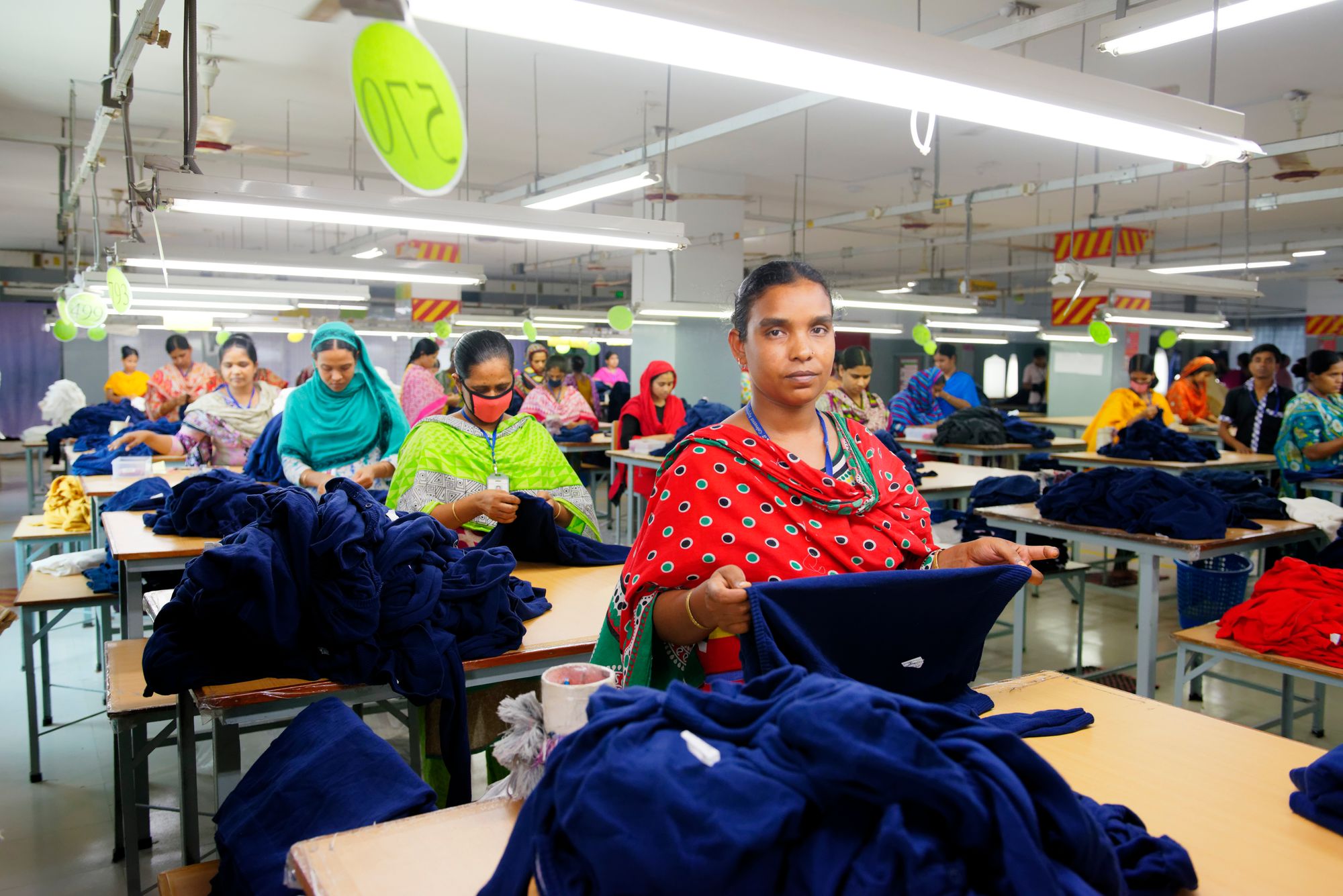
#7 SUSTAINED By The G|O - Friday, August 6th 2021
This is an onsite, slightly edited republication of the complete SUSTAINED - THE SDGS DECODED newsletter of August 6th, 2021
How is the fashion industry joining the SDG runway? You might be forgiven for not immediately linking fashion and the SDGs. But in fact, they are closely related, and it is an issue that is finally getting an enormous amount of attention.
SDG 12 (ensuring sustainable consumption and production) could have been written with the so-called 'fast fashion' industry—read Zara, H&M, and the like—in mind. “SDG 12 is the eye of the storm,” Katia Vladimirova tells us. A senior research associate at the University of Geneva and head of ‘Geneva: City of Sustainable Fashion’ (a study funded by the city), Vladimirova brings the point home with one telling example: “For decades, factories that dye fabrics have been dumping wastewater filled with toxic chemicals directly into rivers in China, changing the very colour of the water and causing damage to local ecosystems and populations.”
We couldn't think of a better guide to explain the significance of the soon-to-be-unveiled EU strategy for sustainable textiles. The document is the response to a 20-year period that has seen a significant rise in unsustainable fashion production and consumption. It will be sweeping, and will regulate both supply and demand in the continent’s fast fashion market.
"Young people grow up with the sense that fashion is disposable"
SUSTAINED: What we are talking about when we refer to fashion?
Katia Vladimirova: Everything we wear. Historically, we have this idea that the fashion industry is glamorous, a privilege of high society. This might have been the case for a long time, but since the 90s, Inditex—the parent company of Mango and Zara, amongst others—revolutionized the concept. Its creator, Armancio Ortega, totally changed the face of the industry, namely by copying the ideas of other brands—in other words, shamelessly replicating designs from the catwalk and making trendy garments more accessible. At the beginning, the media presented the rising market as a democratization of high fashion. This image is changing now.
Democratizing high fashion seems like a nice idea. Where did it go wrong?
KV: At the supply chain. In order to keep prices low and to continue driving them lower, companies like Inditex and H&M moved their production to developing countries. Some nations, for example Cambodia and Bangladesh, are heavily dependent on the fashion economy. It is very cheap to produce there because these countries have weak institutions and poor environmental and labour protection laws. Just recently, a union formed in Bangladesh: They were met with tear gas.
How does the fashion industry impact SDGs?
KV: SDG 12, ensuring sustainable consumption and production, is the eye of the storm. The industry also has a ripple effect in other areas. Most of the workers, both in supply and retail, are women—in other words, a particularly vulnerable population.
On the environmental side, the European Environment Agency recently made a calculation, where they estimate that the consumption of textiles and fashion is the fourth most polluting lifestyle domain in Europe, after mobility, food, and energy use. It is particularly intensive in terms of greenhouse gas emissions, land use, and use of primary resources.
For decades, factories that dye fabrics have been dumping wastewater filled with toxic chemicals directly into rivers in China, changing the very colour of the water and causing damage to local ecosystems and populations. Can you imagine doing this in Switzerland? And yet, this is how things are done. Major factors contributing to a garment’s price, like protection of workers or the environment, became externalities in the fast fashion model.
How has fast fashion consumption evolved statistically?
KV: According to some estimates, fashion consumption has more than doubled since the late 90s. People are buying more. We have data that shows that clothing consumption in Europe has increased by 40% over the last couple of decades, but this is a modest estimate. We’re talking about people buying a lot more, and keeping clothes for a much shorter period of time.
A 2017 report by the Ellen MacArthur Foundation revealed that the average lifespan of garments over the past 20 years has been reduced by 36%. The McKinsey Global Fashion Index also conducted a study [2016], which estimated that people keep garments half as long [as they did 15 years earlier].
So how do we fix it?
KV: From the consumer perspective, the most important thing is to buy less, and to keep your garments for as long as possible. If we need to buy something new, we could start with second-hand clothing, swapping parties or garment rentals. These are collaborative forms of fashion consumption that extend garments’ lifespans. However, when it comes to garment rental, recent research indicates that it is not sustainable at all due to dry cleaning and transport.
When it comes to the supply chain, redistributing profit would be a good place to start. When I speak at conferences and seminars, there is always that guy that tells me that supply chain workers are still better off with jobs, despite the detrimental aspects of the fashion industry. To this, I respond that Ortega has a net worth of 77 billion dollars and receives 400 million in dividends every year, which he invests primarily in real estate. Imagine if this money was instead spent on healthcare and other benefits for workers, or for putting in place water treatment facilities—or even better, technology to ensure no chemicals are poured out into water or soil? We’re talking about a greed magnet that needs to be regulated.
Why are people consuming more, despite rising SDG awareness worldwide?
KV: In the minds of most people, clothes are unrelated to environmental and social havoc. Fashion has only been recognized as a polluting industry for the past 5 years. Mindsets of disposable fashion are strongly instilled. These habits are hard to break.
How has fast fashion changed consumption patterns?
KV: Initial markets for fast fashion have been North America and Europe. These economies are now saturated. In Switzerland, for example, H&M just closed two distribution points.
Over the past few years, the main growth has been happening in emerging economies, such as Russia, South Africa, India, Mexico, and Brazil. They have a growing middle class, with certain lifestyle aspirations. They are currently responsible for the expansion of the fast fashion industry.
There has also been a major cultural shift with Millennials and Generation Z. Young people grow up with the sense that fashion is disposable. Social media enhances the problem: you can only post an outfit once. If an article of clothing gets damaged, one can always buy another instead of repairing it. Thirty years ago, the mentality was very different: Clothes used to be an investment; you had to save up and sacrifice.
Are consumers the main culprits, in your opinion?
KV: I do not like to make consumers the scapegoat because consumption is complicated. Although we all have free will to vote with our money, there are also other factors at play. Availability of time to do research about where to find the right products—or even to think about it, for example. Consuming sustainably is a luxury, because it requires time investment at the initial stage—to learn more, to gain new skills, to change your daily routines.
How are you trying to reverse this unsustainable trend?
KV: I created an international research network on Sustainable Fashion Consumption back in 2018. It just registered its 50th member. We are currently conducting a joint study in which we look at the impacts of COVID-19 on fashion consumption in nine countries: Switzerland, Finland, the US, the UK, India, Iran, Czech Republic, Germany and Hong Kong.
We have been collecting data on how people’s practices have changed with the pandemic, and we came up with some really interesting results. To sum it up, we’re seeing that in lockdowns, many decided to declutter, and re-evaluated their relationship with clothes. Alternatives to fast fashion have not all bloomed, though. Second-hand clothing shopping, for example, has reduced, despite the growth of those platforms online. The complete results will be published this fall.
What is the global community doing to help?
KV: The European Environment Agency has shown through a series of studies over the past few years that fashion should be a priority, with a transition to sustainable consumption. The European Commission and Parliament have also been preparing a document called ‘the EU strategy for sustainable textiles’ that will be coming out in September. The document is supposed to set up a new approach to fashion, and is designed for circularity.
Sustained News in Brief
And the Most Sustainable Tourist Destination Is…
Sweden ranked first—followed by Finland, Austria, Estonia and Norway—in ‘Top Countries for Sustainable Tourism’, a report released by global market research company Euromonitor International. The report concludes that Scandinavia is at the top of the SDG game, through its engagement and progress towards sustainable travel.
A Report for Sustainable Palm Oil
The CMCC Foundation’s latest report, titled ‘The socio-economic aspects related to palm oil production and the achievement of sustainable development goals’, takes a plunge into the palm oil supply chain. Researchers collated 82 scientific publications on the matter published between 2010 and 2020. Their conclusions? Palm oil needs to be made sustainable, rather than eradicated.
Two Billion Dollar Fund for the Weather
Bridgewater All Weather Sustainability was launched earlier this month by the world’s largest hedge fund firm, with two billion dollars promised to weather-friendly businesses. Led by Karen Karniol-Tambour and Carsten Stendevad (Bridgewater’s co-chief investment officers for sustainability), the new fund’s mission will be to rally investors seeking to achieve environmental and social impacts through their portfolios.
When High Fashion Meets SDGs
The Frankfurt Fashion SDG Summit took place on July 7th, in the midst of the city’s Fashion Week. The conference included talks, interviews, panel discussions and performances, with an aim of determining how the fashion industry can become more sustainable.
INTERDEPENDENCE, 2019
This week, SUSTAINED brings you ‘Sunny Day’, a film by Faouzi Bensaïdi about the terrifying future that awaits society due to climate change.* *Interdependence, a series of eleven short (5 to 11 minute) films, was the winner of the Best Narrative Feature at the London Eco Film Festival, in March 2021. The film was produced under the patronage of the UNO in Geneva, WMO and the City of Milan. With production by ART for The World, and Geneva Concept by Adelina von Fürstenberg, the stories, created by eleven international filmmakers from various continents, reflect the intertwining relationships between mankind and the environment, and how they are worsened by climate change in various ways—also hinting at possible solutions. With the participation of the filmmakers Faouzi Bensaïdi (Morocco), Mahamat-Saleh Haroun (Tchad), Ása Hjörleifsdóttir (Iceland), Salome Lamas (Portugal), Bettina Oberli (Switzerland), Nila Madhab Panda (India), Shahrbanoo Sadat (Afganistan), Silvio Soldini (Italy), Daniela Thomas (Brazil), Leon Wang (China), Karin Williams (New Zealand).
Today's Sustained: Sarah Zeines and Philippe Mottaz
Edited by: Dan Wheeler

